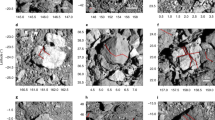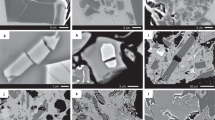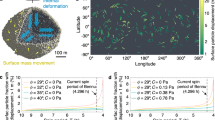Abstract
Bilobate comets—small icy bodies with two distinct lobes—are a common configuration among comets, but the factors shaping these bodies are largely unknown. Cometary nuclei, the solid centres of comets, erode by ice sublimation when they are sufficiently close to the Sun, but the importance of a comet’s internal structure on its erosion is unclear. Here we present three-dimensional analyses of images from the Rosetta mission to illuminate the process that shaped the Jupiter-family bilobate comet 67P/Churyumov–Gerasimenko over billions of years. We show that the comet’s surface and interior exhibit shear-fracture and fault networks, on spatial scales of tens to hundreds of metres. Fractures propagate up to 500 m below the surface through a mechanically homogeneous material. Through fracture network analysis and stress modelling, we show that shear deformation generates fracture networks that control mechanical surface erosion, particularly in the strongly marked neck trough of 67P/Churyumov–Gerasimenko, exposing its interior. We conclude that shear deformation shapes and structures the surface and interior of bilobate comets, particularly in the outer Solar System where water ice sublimation is negligible.
This is a preview of subscription content, access via your institution
Access options
Access Nature and 54 other Nature Portfolio journals
Get Nature+, our best-value online-access subscription
$29.99 / 30 days
cancel any time
Subscribe to this journal
Receive 12 print issues and online access
$259.00 per year
only $21.58 per issue
Buy this article
- Purchase on Springer Link
- Instant access to full article PDF
Prices may be subject to local taxes which are calculated during checkout

(a, b(i), b(ii), c, d(i), d(ii) and e(i)): ESA/Rosetta/MPS for OSIRIS Team MPS/UPD/LAM/IAA/SSO/INTA/UPM/DASP/IDA


(b): ESA/Rosetta/MPS for OSIRIS Team MPS/UPD/LAM/IAA/SSO/INTA/UPM/DASP/IDA

Similar content being viewed by others
Data availability
All the images analysed during the current study are available in the ESA-PSA repository (https://archives.esac.esa.int/psa). The data that support the findings of this study are in the Supplementary Information and available from the corresponding author upon reasonable request (matonti@cerege.fr).
References
Duncan, M., Levison, H. & Dones, L. in Comets II 193–204 (Univ. Arizona Press, Tucson, 2004).
Sunshine, J. M., Thomas, N., El-Maarry, M. R. & Farnham, T. L. Evidence for geologic processes on comets. J. Geophys. Res. Planets 121, 2194–2210 (2016).
Massironi, M. et al. Two independent and primitive envelopes of the bilobate nucleus of comet 67P. Nature 526, 402–405 (2015).
Davidsson, B. J. R. et al. The primordial nucleus of comet 67P/Churyumov-Gerasimenko. Astron. Astrophys. 592, A63 (2016).
Hirabayashi, M. et al. Fission and reconfiguration of bilobate comets as revealed by 67P/Churyumov-Gerasimenko. Nature 534, 352–355 (2016).
Schwartz, S. R. et al. Catastrophic disruptions as the origin of bilobate comets. Nat. Astron. 2, 379–382 (2018).
Jutzi, M. & Benz, W. Formation of bi-lobed shapes by sub-catastrophic collisions. A late origin of comet 67P’s structure. Astron. Astrophys. 597, A62 (2017).
Keller, H. U. et al. OSIRIS – The scientific camera system onboard Rosetta. Space Sci. Rev. 128, 433–506 (2007).
El-Maarry, M. R. et al. Fractures on comet 67P/Churyumov-Gerasimenko observed by Rosetta/OSIRIS. Geophys. Res. Lett. 42, 5170–5178 (2015).
Thomas, N. et al. The morphological diversity of comet 67P/Churyumov-Gerasimenko. Science 347, aaa0440 (2015).
Auger, A. T. et al. Meter-scale thermal contraction crack polygons on the nucleus of comet 67P/Churyumov-Gerasimenko. Icarus 301, 173–188 (2017).
Attree, N. et al. Thermal fracturing on comets. Astron. Astrophys. 610, A76 (2018).
Lee, J. C. et al. Geomorphological mapping of comet 67P/Churyumov-Gerasimenko’s Southern hemisphere. Mon. Not. R. Astron. Soc. 462, S573–S592 (2016).
Penasa, L. et al. A three dimensional modelling of the layered structure of comet 67P/Churyumov-Gerasimenko. Mon. Not. R. Astron. Soc. 469, S741–S754 (2017).
Lyell, C. & Deshayes, G. P. Principles of Geology: Being an Attempt to Explain the Former Changes of the Earth’s Surface, by Reference to Causes Now in Operation (J. Murray, London, 1830).
Steno, N. De Solido Intra Solidum Naturaliter Contento dissertationis prodromus Vol. 78 (Accademia della Crusca, Florentiae, 1669).
Twiss, R. J. & Moores, E. M. Structural Geology (W. H. Freeman and Company, New York, 1992).
Rao, G. et al. Co-seismic Riedel shear structures produced by the 2010 M w 6.9 Yushu earthquake, central Tibetan Plateau, China. Tectonophysics 507, 86–94 (2011).
Matonti, C., Lamarche, J., Guglielmi, Y. & Marié, L. Structural and petrophysical characterization of mixed conduit/seal fault zones in carbonates: example from the Castellas fault (SE France). J. Struct. Geol. 39, 103–121 (2012).
Peacock, D. C. P., Nixon, C. W., Rotevatn, A., Sanderson, D. J. & Zuluaga, L. F. Glossary of fault and other fracture networks. J. Struct. Geol. 92, 12–29 (2016).
Mukherjee, S. Atlas of Structural Geology (Elsevier Science, Amsterdam, 2015).
Mitchell, T. M. & Faulkner, D. R. The nature and origin of off-fault damage surrounding strike-slip fault zones with a wide range of displacements: a field study from the Atacama fault system, northern Chile. J. Struct. Geol. 31, 802–816 (2009).
Soliva, R. & Schultz, R. A. Distributed and localized faulting in extensional settings: insight from the NorthEthiopian Rift–Afar transition area.Tectonics 27, TC2003 (2008).
Cladouhos, T. T. & Marrett, R. Are fault growth and linkage models consistent with power-law distributions of fault lengths? J. Struct. Geol. 18, 281–293 (1996).
Preusker, F. et al. The global meter-level shape model of comet 67P/Churyumov-Gerasimenko. Astron. Astrophys. 607, L1 (2017).
Riedel, W. Zur Mechanik Geologischer Brucherscheinunger.Zentralbl. Mineral. Geol. Paläontol. 8, 354–368 (1929).
Bartlett, W. L., Friedman, M. & Logan, J. M. Experimental folding and faulting of rocks under confining pressure. 9. Wrench faults in limestone layers. Tectonophysics 79, 255–277 (1981).
Ahlgren, S. G. The nucleation and evolution of Riedel shear zones as deformation bands in porous sandstone. J. Struct. Geol. 23, 1203–1214 (2001).
Groussin, O. et al. Gravitational slopes, geomorphology, and material strengths of the nucleus of comet 67P/Churyumov-Gerasimenko from OSIRIS observations. Astron. Astrophys. 583, A32 (2015).
Vincent, J. B. et al. Constraints on cometary surface evolution derived from a statistical analysis of 67P’s topography. Mon. Not. R. Astron. Soc. 469, S329–S338 (2017).
Hatton, C. G., Main, I. G. & Meredith, P. G. Non-universal scaling of fracture length and opening displacement. Nature 367, 160–162 (1994).
Hviid, S. et al. A creaking and cracking comet. In AAS/Division for Planetary Sciences Meeting Abstracts Vol. 48, 211.05 (AAS, 2016).
Attree, N. et al. Tensile strength of 67P/Churyumov–Gerasimenko nucleus material from overhangs. Astron. Astrophys. 611, A33 (2018).
Basilevsky, A. T. et al. Estimating the strength of the nucleus material of comet 67P Churyumov–Gerasimenko. Solar Syst. Res. 50, 225–234 (2016).
Hooker, J. N., Laubach, S. E. & Marrett, R. Fracture-aperture size—frequency, spatial distribution, and growth processes in strata-bounded and non-strata-bounded fractures, Cambrian Mesón Group, NW Argentina. J. Struct. Geol. 54, 54–71 (2013).
Durda, D. D. & Stern, S. A. Collision rates in the present-day Kuiper Belt and Centaur regions: applications to surface activation and modification on comets, Kuiper Belt objects, Centaurs, and Pluto–Charon. Icarus 145, 220–229 (2000).
Weissman, P. R. & Levison, H. F. in The Population of the Trans-Neptunian Region: the Pluto-Charon Environment 559 (Univ. Arizona Press, Tucson, 1997).
Skorov, Y. V., Rezac, L., Hartogh, P., Bazilevsky, A. T. & Keller, H. U. A model of short-lived outbursts on the 67P from fractured terrains. Astron Astrophys. 593, A76 (2016).
Pajola, M. et al. The pristine interior of comet 67P revealed by the combined Aswan outburst and cliff collapse. Nat. Astron. 1, 0092 (2017).
Lai, I. L. et al. Gas outflow and dust transport of comet 67P/Churyumov-Gerasimenko. Mon. Not. R. Astron. Soc. 462, S533–S546 (2016).
Keller, H. U. et al. Insolation, erosion, and morphology of comet 67P/Churyumov-Gerasimenko. Astron. Astrophys. 583, A34 (2015).
Boehnhardt, H. in Comets II 301–316 (Univ. Arizona Press, Tucson, 2004).
Sekanina, Z., Larson, S. M., Hainaut, O., Smette, A. & West, R. M. Major outburst of periodic comet Halley at a heliocentric distance of 14 AU. Astron. Astrophys. 263, 367–386 (1992).
Gaskell, R. W. et al. Characterizing and navigating small bodies with imaging data. Meteorit. Planet. Sci. 43, 1049–1061 (2008).
Bonnet, E. et al. Scaling of fracture systems in geological media. Rev. Geophys. 39, 347–383 (2001).
Acknowledgements
OSIRIS was built by a consortium of the Max-Planck-Institut für Sonnensystemforschung, Göttingen, Germany; the CISAS University of Padova, Italy; the Laboratoire d’Astrophysique de Marseille, France; the Instituto de Astrofisica de Andalucia, CSIC, Granada, Spain; the Research and Scientific Support Department of the ESA, Noordwijk, Netherlands; the Instituto Nacional de Técnica Aeroespacial, Madrid, Spain; the Universidad Politéchnica de Madrid, Spain; the Department of Physics and Astronomy of Uppsala University, Sweden; and the Institut für Datentechnik und Kommunikationsnetze der Technischen Universität Braunschweig, Germany. The support of the national funding agencies of Germany (DLR), France (CNES), Italy (ASI), Spain (MEC), Sweden (SNSB), and the ESA Technical Directorate is gratefully acknowledged. We thank the Rosetta Science Operations Centre and the Rosetta Mission Operations Centre for the successful rendezvous with comet 67 P/Churyumov–Gerasimenko. We also thank Emerson E&P Software, Emerson Automation Solutions, for providing SKUA-GOCAD licenses in the scope of the Emerson Grant Program, V. A. La Bruna for the interesting Structural Geology discussions related to this study, and Y. Guglielmi for his advices on the submission.
Author information
Authors and Affiliations
Contributions
C.M. led this study, mapped the lineaments, performed geological interpretation and wrote most of the manuscript. N.A. performed the 3D projection of the lineaments as well as the statistical calculations and interpretations, and participated in the manuscript writing. O.G. contributed significantly to the interpretations and to the manuscript writing. L.J. provided local and global 3D models and developed tool for images selection and data projection. S.V. contributed to the 3D statistical analysis and data importing to the Gocad software. S.F.H. provided the 3D stress model for 67P. S.B. contributed to improved design of the study, interpretations and manuscript. D.N. contributed to the local and global 3D shape model creation. A.-T.A. contributed to the image selection and geological interpretation. P.L. provided the stereo anaglyph images used for interpretation. H.S., G.N., R.R., D.K. and B.D. are the lead scientists of the OSIRIS project. The other authors are all co-investigators who built and ran this instrument and made the observations possible, and associates and assistants who participated in the study.
Corresponding author
Ethics declarations
Competing interests
The authors declare no competing interests.
Additional information
Publisher’s note: Springer Nature remains neutral with regard to jurisdictional claims in published maps and institutional affiliations.
Supplementary information
Supplementary Information
Supplementary Figures, Supplementary Discussion
Rights and permissions
About this article
Cite this article
Matonti, C., Attree, N., Groussin, O. et al. Bilobate comet morphology and internal structure controlled by shear deformation. Nat. Geosci. 12, 157–162 (2019). https://doi.org/10.1038/s41561-019-0307-9
Received:
Accepted:
Published:
Issue Date:
DOI: https://doi.org/10.1038/s41561-019-0307-9
This article is cited by
-
Alignment of fractures on Bennu’s boulders indicative of rapid asteroid surface evolution
Nature Geoscience (2022)
-
Origin and Evolution of Cometary Nuclei
Space Science Reviews (2020)
-
The familiarity of icy worlds
Nature Geoscience (2019)
-
The Thermal, Mechanical, Structural, and Dielectric Properties of Cometary Nuclei After Rosetta
Space Science Reviews (2019)
-
Surface Morphology of Comets and Associated Evolutionary Processes: A Review of Rosetta’s Observations of 67P/Churyumov–Gerasimenko
Space Science Reviews (2019)



